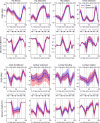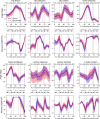Biomechanical features of a novel step-down-and-pivot task in football players with hip/groin pain
- PMID: 40400522
- PMCID: PMC12092111
- DOI: 10.1098/rsos.240908
Biomechanical features of a novel step-down-and-pivot task in football players with hip/groin pain
Abstract
Identifying biomechanical impairments in young, physically active populations with hip/groin pain is crucial for early intervention. This study characterized the biomechanical features of a novel task, the step-down-and-pivot, in competitive football players, comprising 36 individuals with hip/groin pain (28 ± 6 years) and 11 controls (26 ± 4 years). Experimental motion data and ground forces were input into biomechanical models to calculate joint angles and moments, then transformed into principal components and input into a feature selection pipeline. Ten main biomechanical features were identified for each limb, i.e. the pivot limb and the swing limb, that could discriminate between symptomatic and control groups with p < 0.05. In symptomatic individuals, the main features were as follows: pivot limb: smaller hip flexion and knee extension angles, delayed initiation of hip flexion and increased ankle dorsiflexion moment; swing limb: reduced hip flexion moment, increased hip internal rotation moment, delayed hip adduction and knee extension moments, and reduced ankle dorsiflexion angle. The largest group differences occurred during the transitions from step-down to pivot, and pivot to step-forward, supporting a potential role for multi-phase and/or multi-planar tasks when assessing biomechanical impairments due to hip/groin pain. Although biomechanical alterations in our symptomatic participants were small, they could be identified and characterized using feature selection.
Keywords: biomechanics; feature selection; femoroacetabular impingement; gait analysis; hip osteoarthritis; principal component analysis.
© 2025 The Author(s).
Conflict of interest statement
We declare we have no competing interests.
Figures





Similar articles
-
Sub-elite Football Players With Hip-Related Groin Pain and a Positive Flexion, Adduction, and Internal Rotation Test Exhibit Distinct Biomechanical Differences Compared With the Asymptomatic Side.J Orthop Sports Phys Ther. 2018 Jul;48(7):584-593. doi: 10.2519/jospt.2018.7910. Epub 2018 May 8. J Orthop Sports Phys Ther. 2018. PMID: 29739301
-
Lower limb biomechanics during low- and high-impact functional tasks differ between men and women with hip-related groin pain.Clin Biomech (Bristol). 2019 Aug;68:96-103. doi: 10.1016/j.clinbiomech.2019.06.001. Epub 2019 Jun 3. Clin Biomech (Bristol). 2019. PMID: 31181339
-
Running biomechanics in football players with and without hip and groin pain. A cross-sectional analysis of 116 sub-elite players.Phys Ther Sport. 2021 Nov;52:312-321. doi: 10.1016/j.ptsp.2021.10.011. Epub 2021 Oct 25. Phys Ther Sport. 2021. PMID: 34742030
-
Static Ankle Dorsiflexion and Hip and Pelvis Kinematics During Forward Step-Down in Patients With Hip-Related Groin Pain.J Sport Rehabil. 2020 Dec 8;30(4):638-645. doi: 10.1123/jsr.2020-0140. J Sport Rehabil. 2020. PMID: 33291065 Free PMC article.
-
Contributions to the understanding of gait control.Dan Med J. 2014 Apr;61(4):B4823. Dan Med J. 2014. PMID: 24814597 Review.
References
-
- Heerey JJ, Kemp JL, Mosler AB, Jones DM, Pizzari T, Souza RB, Crossley KM. 2018. What is the prevalence of imaging-defined intra-articular hip pathologies in people with and without pain? A systematic review and meta-analysis. Br. J. Sports Med. 52, 581–593. (10.1136/bjsports-2017-098264) - DOI - PubMed
-
- Reiman MP, et al. . 2020. Consensus recommendations on the classification, definition and diagnostic criteria of hip-related pain in young and middle-aged active adults from the International Hip-related Pain Research Network, Zurich 2018. Br. J. Sports Med. 54, 631–641. (10.1136/bjsports-2019-101453) - DOI - PubMed
Associated data
LinkOut - more resources
Full Text Sources

